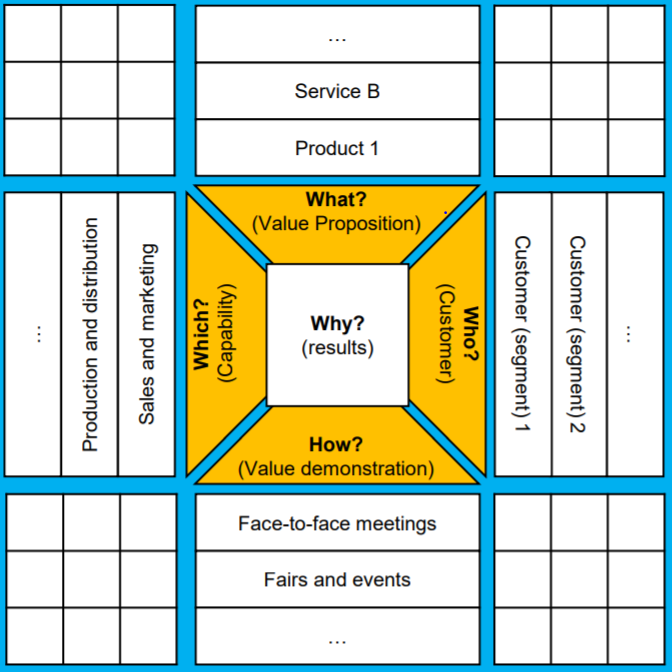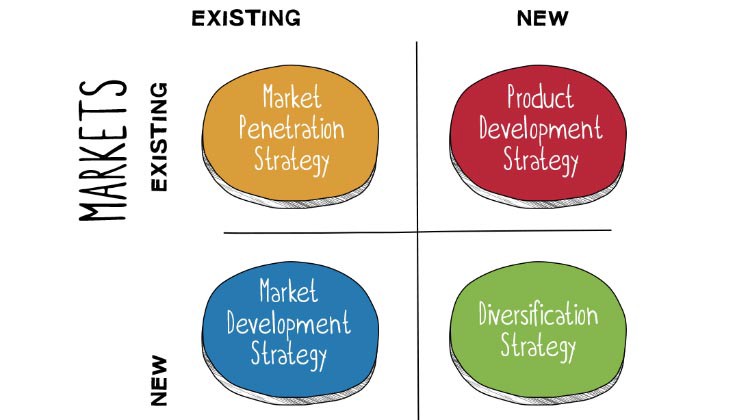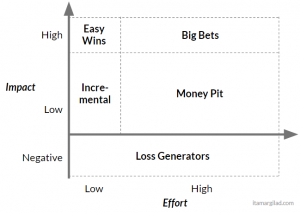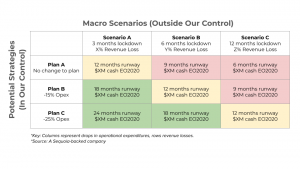Future-Proofing Your Business Strategy In Uncertain Times
2020 has brought its load of unexpected events. The types of events that have a “before” and an “after”. What is unprecedented is the lack of predictability of what is to come. So, what strategy to follow to set your business in a position to succeed in these uncertain times? That’s why I tried to answer gathering best practices together with Sebastian Mueller, COO of Ming Labs, and Pierre-Etienne Bost, co-founder of All Leaders Initiative.
Dimensions to Evaluate Your Strategic Options
What is the world cooking
Whatever the context might be, your organization’s success will depend its ability to create awareness about the possible scenarios to come. A global pandemic has to be looked at through various lenses. The public health situation is an important indicator of course. But there are other elements to keep a close eye on. Among the main ones, the governments’ measures and their subsequent impact on the macroeconomic environment. Among the multitude of information available online, I did find value in this report from BoardOfInnovation.com that shows some key market trends (note: you’ll receive it after sharing your email with BoardOfInnovation).
While you work on possible scenarios, you can select the most relevant criteria for scenario definition based on your business specifics. For example, you can pick two dimensions where one is lockdown duration over the next 12–24 months and the other the revenue evolution forecast.
Time for a little introspection…
Evaluating your strategic options definitely requires a good level of self-awareness. For an internal diagnostic, I do recommend the model of Ritter and Pedersen, Department of Strategy, Innovation, and Marketing from the Copenhagen Business School.

It is structured around 5 main domains. Customer (Who), Value Proposition (What), Capability (Which), Value Demonstration (How), and eventually the Results (Why). Here are the main questions you can address in each area.
Customer / The Who
Who were your customers? How does the demand evolve? Are the problems you are solving still relevant?
Value Proposition / The What
What do you sell? Which kind of value propositions do you offer? How is this impacted by the crisis?
Capability / The Which
Which capabilities did your organization have? What are the areas impacted or at risk?
Value Demonstration / The How
How do you demonstrate your value propositions to convince customers to buy them? Is this impacted by coronavirus?
Results / The Why
How are your results impacted by the crisis (e.g., turnover, profits, social and climate contributions)?
With such assessment done, you will have gathered precious information and knowledge that will be of tremendous value moving to make the most beneficial decisions.
Better Strategizing – The Science Of Making Good Bets
After you have made the initial adjustments necessary and took stock of the cards you are holding, it is time to look forward and design your strategy.
Thinking in Bets
As usual in organizations, there are more things to do than there are resources. So, the key is in putting the effort and attention on the right initiatives. The ones that will make a positive impact. In an environment filled with uncertainty, the number of possible initiatives increases and it becomes even more important to rationalize the decision making on what to do, and what not to.
For this, thinking in probability will be of great help. At least at two levels. The first one is the probability that an initiative delivers the impact it is expected to. The second is based on the environmental trends and probability each possible future scenario becomes a reality. Let’s see how to put that in practice.
List Your Potential Plays
This exercise can be made very sophisticated and complex…or very simple. Let’s aim for the latter. There are two methods I do find very valuable yet easy to implement to list possible options after a strategic diagnosis.
The Ansoff Matrix
 First, the Ansoff Matrix is a very easy way to segment your possible plays based on their nature. Is your strategic idea linked to an existing market or to a new one? Is it an existing product or a new one? Depending on the assets of your organization, one block will be easier to move in than others. You can also split the fun towards the different teams to see what comes out of the different areas of the organization.
First, the Ansoff Matrix is a very easy way to segment your possible plays based on their nature. Is your strategic idea linked to an existing market or to a new one? Is it an existing product or a new one? Depending on the assets of your organization, one block will be easier to move in than others. You can also split the fun towards the different teams to see what comes out of the different areas of the organization.
Qualify to compare…
 Getting an overview is an important first step. All initiatives do not come with the same level of effort, the same impact, or the same probability to activate. Qualifying your possible plays will help you make the most rational and unbiased decision making. Will help you see the low hanging fruits from the big bets. The Impact / Effort view is a very helpful one for that exercise. Up to you to define how to measure effort (man-days; cost; complexity; a weighted mix of all) and impact (revenue; cashflow; image; strategic position; a weighted mix of all).
Getting an overview is an important first step. All initiatives do not come with the same level of effort, the same impact, or the same probability to activate. Qualifying your possible plays will help you make the most rational and unbiased decision making. Will help you see the low hanging fruits from the big bets. The Impact / Effort view is a very helpful one for that exercise. Up to you to define how to measure effort (man-days; cost; complexity; a weighted mix of all) and impact (revenue; cashflow; image; strategic position; a weighted mix of all).
Arbitrate & Decide — Making Your Bets
Once you know what are all the options, the time has come to bring it all together and decide what are the things you should stop, what are the ones you should start, and the areas you should keep or improve. You can use the KISS framework — Keep / Improve / Start / Stop.
To decide, you’ll be able to leverage the qualification work done previously as well as your organization’s willingness to take risks. It is also an opportunity to accelerate in domains that are the most future-proof such as digital transformation.
This is what Nike did when the crisis first hit in China. They pivoted all their sales and marketing towards digital channels and could mitigate impact effectively and produced good numbers. They now claim they have a playbook for other regions — an interesting article by Rob Walker on the topic.
Scenario-based cashflow feasibility check
 With the above, you should now get a clearer view of the strategic initiatives that will get your utmost attention in the times to come. Yet before moving into strategy execution and confirm feasibility with your finances, you’ll want to check the impact on cash flow depending on the scenarios and get this in one overview. A useful reference for this task comes from Sequoia
With the above, you should now get a clearer view of the strategic initiatives that will get your utmost attention in the times to come. Yet before moving into strategy execution and confirm feasibility with your finances, you’ll want to check the impact on cash flow depending on the scenarios and get this in one overview. A useful reference for this task comes from Sequoia
Once you have the portfolio of actions you want to start with, your next considerations will be around strategic planning and execution. Getting things done.
Key Levers To Turn Your Strategy Into Reality
 Strategy delivery is a science. Some initiatives will be easy to implement and require little resources. Some will be heavier and require internal or external collaboration. Success isn’t guaranteed and requires high focus, proper organization as well as methods to engage teams, continuously learn, and improve execution effectiveness. No surprise if Bridges Business Consultancy Int. survey find out that 67% of strategies do fail because of poor execution. So — while your strategy is defined — still most of the value remains to be extracted and delivered. Here are the main things to look at the maximize your strategic effectiveness.
Strategy delivery is a science. Some initiatives will be easy to implement and require little resources. Some will be heavier and require internal or external collaboration. Success isn’t guaranteed and requires high focus, proper organization as well as methods to engage teams, continuously learn, and improve execution effectiveness. No surprise if Bridges Business Consultancy Int. survey find out that 67% of strategies do fail because of poor execution. So — while your strategy is defined — still most of the value remains to be extracted and delivered. Here are the main things to look at the maximize your strategic effectiveness.
Focus — Less Is More
How many initiatives linked to strategy is your organization running in parallel? 10? 20? Well, any figure above the first one is certainly too high. So, can you tell what are the 3 to 5 top initiatives are prioritized above all the rest? And can all the teams also name them? With such a focus your teams will spend less time wondering what is the right thing to work on, and more time co-delivering excellence. And keeping continuity in these priorities is also of importance to avoid the “headless chicken” syndrome.
“Really Successful People Say No To Almost Everything” — Warren Buffet
Engagement — Strategic Execution Is Not Story Of A Few…
Too often, executing the strategic initiatives is the priority of a handful of people and the delivery teams have a bigger focus on the day-to-day. That is a big challenge to address as it slows down strategic execution, generate conflicts of priorities, and ultimately decrease everyone’s engagement towards the purpose of your organization. The strategy shall be concern of everyone. Fortunately, there are ways to avoid the common pitfalls here. We’ll talk about that a bit later in this article.
Targeted Approach — Not Every Strategic Initiative Shall Be Handled The Same Way
Depending on their complexity, impact, and risk-profile, your strategic initiatives shall be addressed differently.
The low-risk, low-complexity initiatives, which you have likely identified as low-hanging fruits, can move into execution swiftly. Find the right owner for the action and ensure that they are aligned with the expected impact and outcome.
For the more risky and more complex initiatives, taking a discovery-driven approach will allow you to de-risk them quickly. You can leverage methodologies borrowed from Design Thinking and Lean Start-Up, which will help you understand the intended target audience better and frame the problem well.
Learning and Agile mindset
 The key to all of this is a vigorous learning mindset. The future is extremely uncertain, ambiguous, and complex. We act under highly imperfect information. From every initiative you run, you want to get as much learning as possible into your organization, to adjust quickly.
The key to all of this is a vigorous learning mindset. The future is extremely uncertain, ambiguous, and complex. We act under highly imperfect information. From every initiative you run, you want to get as much learning as possible into your organization, to adjust quickly.
Supporting your organization to be in the right “safety” mindset to collectively experiment, fail, learn, iterate, grow, and ultimately succeed will make a difference. Having forums to look back and learn, unleash creative thoughts, and challenge status-quo are some of the initiatives that can be set-up for that purpose.Here a perspective of McKinsey that reflects on how agile (and digital) can support a post-covid19 recovery.
Adjust Your Organization To Bring Better Performance And Alignment
Essential key success factors for an outstanding strategy delivery are the teams. Finding ways to collaborate, have dialogue, and engage better will be the driving change to a more effective execution. Let’s go through some methods and best practices.
When your organization gets bigger, Portfolio Management practice allows teams to consolidate and incubate strategy related ideas in a transparent, structured, and rationalized way as well as to monitor and support progress until delivery. This will allow the leadership team to have visibility and continuous dialogue about the execution of these initiatives.
OKR — A Method For The Teams To Focus On What Matters
If you want to encourage cross-department collaboration, agility as well as a result-driven and pro-active culture, you can explore the management strategy method named OKR. OKR stands for Objectives and Key Results. Used by Google, Linkedin, GoPro, and many of the top innovative companies worldwide, this method has proven to be very helpful to get teams active and engaged with the company’s purpose and strategic direction and become more outcome-driven. Besides, as it promotes a culture of transparency, OKR enables early visibility on redundant efforts.
Long-term goals establish direction and define success. Short-term goals impact daily behavior.
This can work for very large organizations as well as start-ups — many are already using it in the Silicon Valley but also more and more across continents. To get a feel, you can watch this 10m TED Talk by John Doerr, early investor at Google, and one of the main sources of the OKR spread. Also, Felipe Castro, a global OKR evangelist, has written a lot about it. He also happens to have introduced me to OKR.
OKR also empowers your organization to deliver with continuous learning and an agile mindset. Beyond the traditional 3-5 years strategic plan, having an iterative review of the strategic focus every 3 to 6 months will allow teams to have a sharp focus on where it matters most and the organization to learn and adapt based on what happened in the previous cycle.
A Culture Of Purpose And Safety
Purpose has always been a key motivation and engagement driver for coworkers, customers, and partners. Millennials who have a strong connection to the purpose of their organization are 5.3 times more likely to stay. PWC Study. And engagement translates into performance. EY Global Leadership Forecast confirms that purposeful companies outperform the stock market by 42%. A well-implemented culture of safety can bring various benefits:
- It helps anticipate crises and risk thanks to a culture of resilience and sustainable thinking
- It optimizes value creation through short-term adaptability, creativity, and global performance perspective.
You can find more info on the topic here by All Leaders Initiative
So, to wrap up on strategy execution, various methods and tools are available to help you keep teams highly engaged and execute swiftly on what matters. All of that, with a learning mindset, the desire to continuously thanks to a culture of purpose and safety and agility by design.

I hope you found this read useful and that you’ll find there great opportunities for your company and teams. In that context, I wish the few actions and steps put together here can be of help. This article is the synthesis of a 4 article series posted here:
- Ep. 1- First Things First In Times of Crisis. About the key urgent actions to take when hit by a crisis and some best practices to help set everyone’s mindset for what is to come.
- Ep. 2- 6 Dimensions To Evaluate Your Strategic Options. Some information and tools to assess the latest environmental trends put together with a simple method to perform a strategic diagnosis.
- Ep. 3- Better Strategizing – The Science of Making Good Bets. About the ways to leverage all the information you gathered to make the best possible decisions for a way forward for your business.
- Ep. 4- Execution Excellence — Key Levers To Turn Your Strategy Into Reality. About the levers and methods to translate your strategic initiatives into action.
“Good business leaders create a vision, articulate the vision, passionately own the vision, and relentlessly drive it to completion.” — Jack Welch
Innovation & Strategy Insights straight to your Inbox
No spam, promise. Unsubscribe anytime.



